Billericay, Essex
Up to 1834
The early workhouse directory An Account of Several Workhouses..., published in 1725, notes the existence of workhouses at "Billerica" and Brentwood. The Billericay workhouse may have dated from as early as 1719 when parish records note that a bond for £50 was borrowed in connection with the building of a house for the poor. According to (Grounds, 1968) the workhouse stood 'not far from Sun Corner' on Laindon Road, to the south of the town, and was a three storey building with twelve rooms.
A parliamentary report of 1777 recorded parish workhouses in operation at Brentwood (for up 14 inmates), Great Burstead (40), and Shenfield (30). The town of Billericay lay within the Great Burstead parish so either name may be used to refer to the same establishment
Brentwood's workhouse was located on Back Street. The Shenfield workhouse stood to the north-east of Brentwood, just across the parish boundary which divided the two parishes. In 1837, the Shenfield premises were sold off by auction at the Green Dragon public house for £380. The Shen Place almshouses now occupy the site.
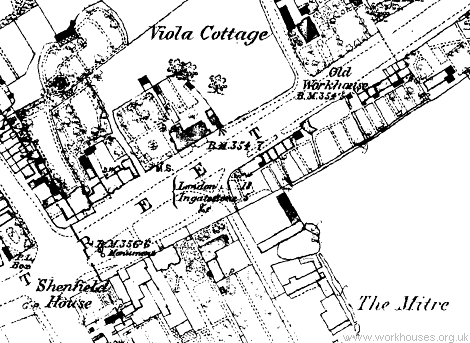
Shenfield former parish workhouse site, 1873.
After 1834
Billericay Poor Law Union was formed on 10th October 1835. Its operation was overseen by an elected Board of Guardians, 29 in number, representing its 26 constituent parishes as listed below (figures in brackets indicate numbers of Guardians if more than one):
County of Essex:
Basildon, North Benfleet, South Benfleet, Bowers Gifford, Brentwood (2), Great Burstead (2), Little Burstead, Childerditch, Downham, Dunton, East Horndon, West Horndon, Hutton, Ingrave, Laindon, Mountnessing, Nevendon, Pitsea, Ramsden Bellhouse, Ramsden Crays, Shenfield, Thundersley, Vange, Little Warley, South Weald (2), Wickford.
Later Additions: Basildon, Lee Chapel (from 1858).
The population falling within the Union at the 1831 census had been 12,529 — with parishes ranging in size from West Horndon (population 63) to Great Burstead (1,977). The average annual poor-rate expenditure for the period 1833-35 had been £8,559 or 13s.8d. per head of the population.
The new Billericay workhouse was built in 1839-40 on an 11½ acre site in Billericay known as Stock Hill Field, between Stock Road to the west and Norsey Road to the east. It was designed by George Gilbert Scott and William Bonython Moffatt where were the architects of many other workhouses during this period including ones for the Witham, Dunmow and Tendring Unions. Their design for Billericay was in an Elizabethan Tudor style and cost £11,000 to build.
The main entrance to the site was at the south on Norsey Road where a porter's lodge was located. The main workhouse block was a large H-shaped building facing to the south. The workhouse's location and layout can be seen on the 1896 map below.
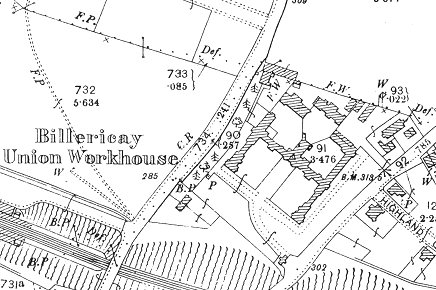
Billericay workhouse site, 1896.
The Master's quarters lay at the centre of the main block.
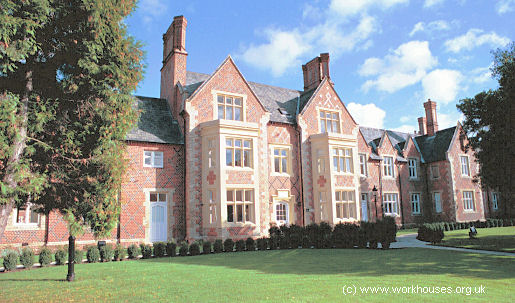
Billericay Master's entrance from the south-west, 2000.
© Peter Higginbotham.
A plaque above the main entrance door reads "Billericay Union House Erected AD 1840 John Brewitt of Bridge House Wickford Equire Chairman."
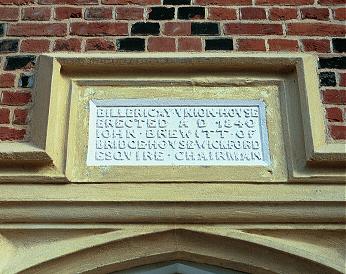
Billericay entrance plaque, 2000.
© Peter Higginbotham.
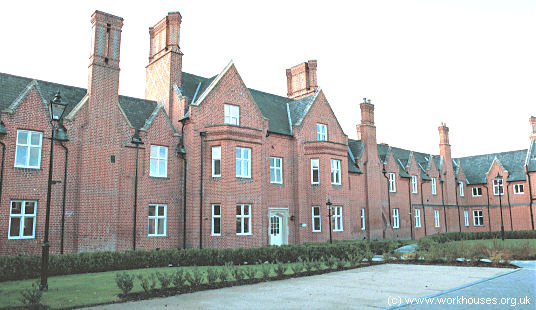
Billericay rear of main block from the north-east, 2000.
© Peter Higginbotham.
Females were accommodated at the west of the site and males at the east, with children residing in the central and southern portion of the side-wings. The south-west wing included a nursery and receiving wards and a chapel at its far end.
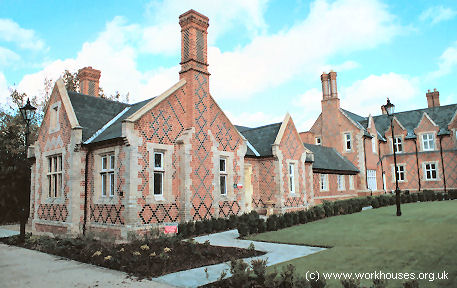
Billericay chapel (left), nursery, and girls' wing from the south, 2000.
© Peter Higginbotham.
The Guardians' board-room was located at the southrn end of the boys' wing, opposite the chapel.
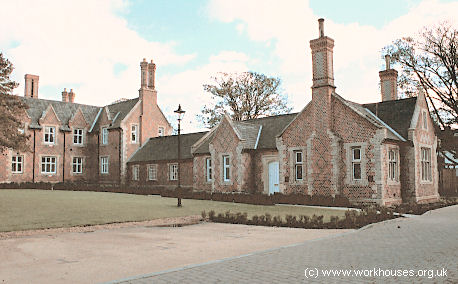
Billericay board-room (right) from the south-west, 2000.
© Peter Higginbotham.
The open space at the south ouf the main building was used for boys' and girls' playgrounds. The areas at northern side of the main building was used to provide "airing courts" for the adult inmates.
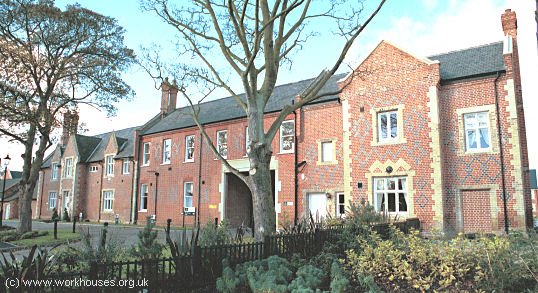
Billericay male side from the north-east, 2000.
© Peter Higginbotham.
In 1898, additional land was acquired to the north of the workhouse. Additions included an infirmary to the north of the workhouse, and casual wards and a Labour Master's house at the north-west accessed from their own entrance on Stock Road. Further developments were a receiving ward near the main entrance in 1907, and a new infirmary at the north in 1927.
The workhouse, or at least its casual ward, became known locally as "The Grubber" — presumably because it provided "grub" or food.
After 1930, the workhouse became Billericay Public Assistance Institution under the control of Essex County Council. The site later became St Andrew's Hospital but following its closure in 1998 has now been redeveloped for residential use.
Geoff Hare, whose father George was the ambulance driver at the hospital until 1959 and, before that, as a driver with Ted Bull who supplied horse and driver for the horse drawn ambulance, recalls:
Before the EMS (Emrgency Medical Scheme) hospital huts were built, there was a piggery behind the "new" hospital buildings. The Essex County Council organised a "swap shop" of hospital produce.
Billericay Children's Home
"Foxcroft", a house at 100 High High Street in Billericay, was once used by the union as a children's home.
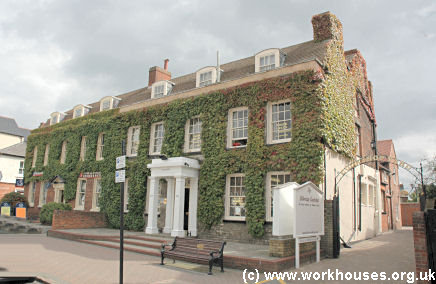
Billericay children's home, 2006.
© Peter Higginbotham.
Staff
Inmates
Records
Note: many repositories impose a closure period of up to 100 years for records identifying individuals. Before travelling a long distance, always check that the records you want to consult will be available.
- Essex Record Office, Wharf Road Chelmsford CM2 6YT. Holdings include: Guardians' minutes (1835-1915, 1920-30); Ledgers (1835-1930); etc.
Bibliography
- Andrews, D.D. (2002) Historic Buildings Notes and Surveys - St. Andrew's Hospital, formerly the Billericay Union Workhouse, Essex Archaeology 33, 414-442
- Grounds, W .M. (1968) The Old Billericay Workhouse (in Essex Journal, vol.3, no.4, pp.218-22)
- Jackson, QM (1983)A Brief History of St Andrew's Hospital 1840-1982.
Links
- None.
Unless otherwise indicated, this page () is copyright Peter Higginbotham. Contents may not be reproduced without permission.


